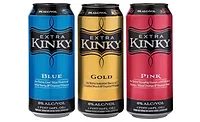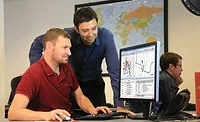FMCSA mandates change telematics requirements
Telematics adapt to rugged beverage industry needs
From smartphones and tablets to electric cars, technology only seems to have made life easier, and several technological innovations have done just that for the beverage industry as well. In fact, there has been a recent boom in telematics innovations for the beverage distribution industry, according to industry experts. Many of the telematics devices that beverage delivery drivers use every day are quickly evolving from a keypad style to a touch screen. Telematics suppliers also are including interfaces that are similar to tablets and smartphones to make them more user friendly and adding more and more benefits and features as the technology evolves.
Technological benefits aside, Mike Dennis, group director of maintenance operations in North America for Miami-based Ryder Systems Fleet Management Solutions, says the telematics industry will only continue to grow in the next few years as government mandates require fleets to further utilize telematics devices.
“In September … there will be more telematics providers than you can shake a stick at,” Dennis says. “In fact, if you’ve got a soddering gun and an electronics background, get your garage ready because you can become a new telematics provider.”
Knowing the law
A few years ago, the U.S. Department of Transportation’s Federal Motor Carrier Safety Administration (FMCSA) initiated hours-of-operation mandates, which were designed to help reduce driver fatigue and, in turn, accidents caused by fatigue. In September, FMCSA will expand upon this mandate by requiring interstate commercial truck and bus companies to use electronic logging devices (ELDs) in their vehicles, it says.
According to the FMCSA, the proposed mandate would significantly reduce the paperwork burden associated with hours-of-service recordkeeping for interstate truck drivers and improve the quality of logbook data. Additionally, the new protocol will ultimately reduce hours-of-service violations by making it more difficult for drivers to misrepresent their time in logbooks to avoid detection by FMCSA and law enforcement personnel, it says.
“Today’s proposal will improve safety while helping businesses by cutting unnecessary paperwork,” said Anthony Foxx, transportation secretary for FMCSA, in a statement. “By leveraging innovative technology with electronic logging devices, we have the opportunity to save lives and boost efficiency for both motor carriers and safety inspectors.”
The administration says that, by reducing crashes caused by fatigued drivers, it can prevent approximately 20 fatalities and 434 injuries each year, which is a benefit of $394.8 million, it says.
Ryder’s Dennis estimates that approximately 5 million fleet vehicles on the road will be affected by the new mandate. However, experts say it’s hard to determine what the return on investment will be for these fleets’ $500 - $1,500 hardware investments and the additional costs for the telematics software.
Zebra Technologies International LLC’s Senior Director of Transportation Logistics Mike Maris notes that the situation is more about compliance than profitability. However, there is no way to avoid the added costs that can accrue for many beverage companies, he says. “The added costs are obvious,” he says. “When you have to start elogging, you have to figure out how you’re going to pay for that, which is the main [concern]. The companies who do well by it will take it from a cost perspective and use that to manage its fleet more effectively.”
To help ease the financial burden associated with the new mandate, Ryder plans to offer its customers a subscription-based model for the telematics solutions that they support, which can eliminate some costs, Dennis says. “It would be much like your cable bill,” he explains. “Our goal is to offer our customers a subscription-based model, so they don’t have the expenditure of buying all that equipment.”
Under the new mandate, companies will have 24 months to equip their fleets with ELDs, which isn’t that long when considering that this process includes installing equipment in an entire fleet of vehicles and training drivers on the new equipment, Ryder’s Dennis points out.
Changing faces
However, training drivers on the new equipment becomes easier every year as telematics providers strive to manufacture equipment that is more user friendly. For example, Ryder’s Dennis says that one of the biggest trends in telematics right now is the growth of driver-facing, user friendly, touch-screen interfaces. However, many companies still are utilizing the less-expensive keypad solutions, both Ryder’s Dennis and Zebra’s Maris note, but this is quickly changing.
Maris says he notices interest in Zebra’s more recent models, namely the TC70 and the TC75, which are touch-screen, in-cab devices that offer the same functions of a traditional format. “This gives you the same user interface as your iPhone or Android phone, and you can use color and icons to make a much friendlier interface,” Maris says. “The one exception we see coming around is that I have some customers who are now putting tablets into trucks to do that same interfacing. It’s a little bit on the cutting edge because tablets weren’t really built to handle the rugged vibrations and the hot and cold temperatures you typically find when left in trucks.”
However, Zebra now offers its ET1 Enterprise Tablet (ET1), which offers a 7-inch screen that gives the drivers more screen space to receive better turn-by-turn directions, check email and log hours. Unlike other tablets, the ET1 allows the user to wear gloves and operate it when its raining. Maris says that the ET1 also maintains a memory of how a user operates the device. For example, if a driver tends to tap a particular icon too high, in the future, the device will remember that when the user taps in that location again, he explains. “So we’re really doing a lot of logical things here to better understand and allow that driver to do a better job on entry,” he says.
More benefits
Beyond ease of use for the driver, telematics features are evolving to allow managers in the back office greater access to the truck and to monitor its cargo inside, Ryder’s Dennis says. Ryder offers solutions that allow a beverage company to remotely monitor and change temperatures in a refrigeration trailer. This is especially important given the rise of all-natural beverage options, which require refrigeration and might spoil more easily during transport, he notes.
Zebra’s Maris says that government regulation of truck temperature might also be just around the corner. “The one thing that we see that’s really going to be a game-changer, especially for the beverage and foods industries, are sensors that are going to be on board that will talk to the same telematics devices and then send the data from the truck back to the server,” Maris says.
Beyond product-condition monitoring, product-location monitoring also will continue to be an important task for telematics equipment, Maris says. “What you’re going to see, especially in the beverage business, is additional sensory and logging caps, such as real-time location tracking (RTLS),” Maris continues. “So not only will [a company] know how that driver is driving, not only will [the company] know how the engine is performing, but [the company] will know where that person, that asset, is at any one time.”
Maris adds that there also will be more cameras added around trucks for extra security. Because of the security benefits that telematics equipment provides, companies that utilize these solutions tend to have less-expensive insurance rates as well.
These monitoring devices also can help with insurance disputes down the road, Maris points out. “A lot of times, big trucking companies, especially in beverage, get blamed for backing into someone’s car, things like that,” he explains. “Now with the information from the cameras, we know where the truck is, and who’s on it and driving it. Many times [companies] can dispute and win the dispute, [because of] these cameras. It’s really going to be a money saver coming down the road.”
Looking for a reprint of this article?
From high-res PDFs to custom plaques, order your copy today!






